|
Author
|
Topic: NASA JSC Lunar Receiving Laboratory (LRL)
|
hlbjr
Member Posts: 582
From: Delray Beach Florida USA
Registered: Mar 2006
|
 posted 08-04-2006 11:56 AM
posted 08-04-2006 11:56 AM
   
I was wondering what NASA is doing with the building that was the Lunar Receiving Laboratory? |
Robert Pearlman
Editor Posts: 52878
From: Houston, TX
Registered: Nov 1999
|
 posted 08-04-2006 12:20 PM
posted 08-04-2006 12:20 PM
   
The Lunar Receiving Laboratory, Building 37 at JSC, is now mostly used for life sciences. In 1970, the LRL was replaced by the Lunar Sample Laboratory Facility, Building 31N. |
trchambers
New Member Posts: 6
From: china
Registered: Sep 2006
|
 posted 09-14-2006 08:52 PM
posted 09-14-2006 08:52 PM
   
My name is Tom R. Chambers, and I worked in the biological sciences section at the Lunar Receiving Laboratory [LRL] during the Apollo Program [Apollo 12, 13, 14, 15, 16 and 17].I worked with Landrum Young, the group leader, and others by injecting lunar fines samples into mammalian models such as mice and rats to determine if the lunar fines were contaminated. It was a great experience working through containment cabinets by using rubber gloves to handle the animals and the lunar fines. We did this for missions 11 [not there for the first one], 12 and 14. After Apollo 14, we were able to work with the lunar fines in the open for missions 15, 16 and 17, and we continued the same methodology with increased documentation and experimentation. I worked with peritoneal lavage using the lunar fines. Later... after the Apollo Program... I published a paper for Laboratory Animal Science based on this technique [1974]. I suggested to Landrum Young that we write a technical paper based on our approach of collecting blood samples from mice and rats. We put together a short paper which was published in Laboratory Animal Science [1972], and later we received a first place award from the organization for best technical published that year. I did quite a bit of photomicroscopy of the lunar fines within a biological context and also did some electrophoresis work looking at mouse enzymes. I published a paper on this as well. I'll never have an experience like the LRL one again. There was great excitement in the air. And having to put on scrubs and go through UV tunnels to and from work was an interesting process. If you were there at the same time... and we met... please reply to this post. I would like to hear from you. |
mjanovec
Member Posts: 3811
From: Midwest, USA
Registered: Jul 2005
|
 posted 09-14-2006 11:21 PM
posted 09-14-2006 11:21 PM
   
The work you did sounds like it was very interesting. I am curious whether the mice showed any adverse reactions to the lunar fines at all... or whether they were unaffected by them.Anyway, I was wondering if you recognize yourself in any of these photos... or whether you can identify who are in these photos. 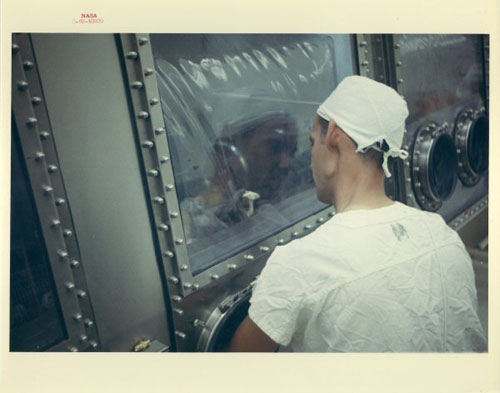 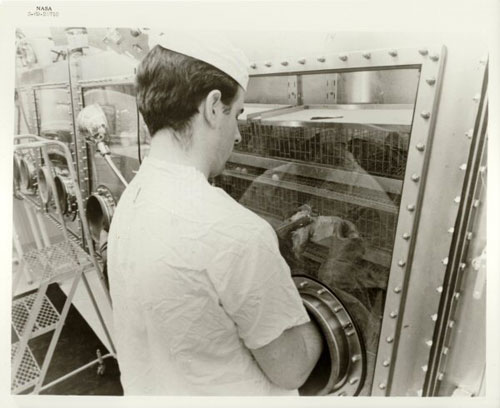
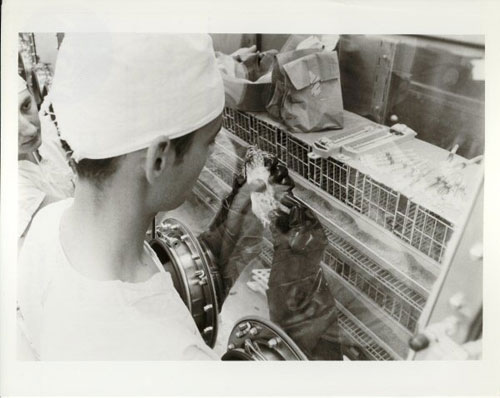
Thanks for joining collectSPACE. It's good to hear from people who worked in all aspects of the lunar missions! |
trchambers
New Member Posts: 6
From: china
Registered: Sep 2006
|
 posted 09-15-2006 12:02 AM
posted 09-15-2006 12:02 AM
   
Good to get a reply and some photos. I believe these photos were taken before I arrived. I didn't start working there until Apollo 12. The bottom picture is Landrum Young, and the first two pictures also show Landrum Young [seated in the first picture]. He was my boss.And who are you? |
trchambers
New Member Posts: 6
From: china
Registered: Sep 2006
|
 posted 09-15-2006 12:03 AM
posted 09-15-2006 12:03 AM
   
I forgot to mention that there were no adverse effects. |
trchambers
New Member Posts: 6
From: china
Registered: Sep 2006
|
 posted 09-15-2006 12:10 AM
posted 09-15-2006 12:10 AM
   
I just looked at the last picture closely and yes, I'm in the picture to Landrum Young's left. You can just barely see my face.Wow... first time to see this picture! This was probably taken in 1969 or 1970, so 36 to 37 years ago! I was just a kid... 22 or 23! I turned 59 a few weeks ago. |
mjanovec
Member Posts: 3811
From: Midwest, USA
Registered: Jul 2005
|
 posted 09-15-2006 12:29 AM
posted 09-15-2006 12:29 AM
   
I had no involvement in the programs...I'm just an enthusiast in all things involving the lunar program. I coincidentally just received scans of those photos when your post showed up on collectSPACE. So I thought I would share them with everyone. Glad to see you found yourself in the one of the pics. |
trchambers
New Member Posts: 6
From: china
Registered: Sep 2006
|
 posted 09-15-2006 04:41 AM
posted 09-15-2006 04:41 AM
   
Thanks again for posting the images. Seeing the containment cabinets really brings back vivid memories of my involvement.I remember my first encounter with the cabinets. The process of working [doing everything] through rubber gloves was surreal, and this feeling added to the feeling of excitement of just being a part of the Apollo Program. The otherwordly surroundings of the Lunar Receiving Laboratory [LRL] of scrub suits, UV showers, big metal containment cabinets, sterilization chambers [autoclaves], etc. were befitting of a space program, and I felt if I was riding with them on their journey to the moon and back. While the astronauts were on their way to the moon, on the surface and coming back from the moon, everyone... including me... was on pins and needles and in great anticipation of receiving the lunar samples. I don't think anyone got a good night's sleep during this phase of each mission. Again, there was a special feeling of something "alien" coming to our confines to be studied. I suppose I can say "alien" even though the moon is a part of mother Earth in its continual orbit around it. And for me [probably everyone]... even through the glass of the containment cabinets... just seeing the lunar fines [dirt] as samples for our mammalian testing conjured up this incredible feeling of working in an "alien" environment and doing something in the history of mankind for the first time. I kept think [still do] that out of the hundreds of millions of individuals who had raised their heads towards the sky and looked at the moon since the beginning, here I was looking at it just a few inches away... an unbelieveable experience. So I can imagine how the astronauts must have felt actually walking and digging on the moon. And after the containment procedures were set aside for missions 15, 16 and 17, we were able to actually handle... via test tubes and in vials/crucibles... the lunar fines out in the open. This provided even more of an up close and personal approach. It was a sad day when the Apollo Program came to an end. Most of our positions [mine included] were phased out, and we had to move on. Other involvements seemed anticlimactic after the NASA gig. I continued doing research at the University of Texas Medical Branch at Galveston for a few years then moved into medical media and communications at Texas Tech University and then into political media and communications for the Mayor's Office in Providence, Rhode Island. Later, I served as a United States Peace Corps Volunteer in Zimbabwe developing arts programming and training staff in curatorial preparation for the National Gallery of Zimbabwe. I enjoyed this immensely, and I liked my Kennedy connection with two of the late President's initiatives: Peace Corps and Apollo Program. I'm currently Visiting Lecturer in Digital/New Media Art for Zhaoqing University, Zhaoqing, China. You can take a look at my website. |
rjurek349
Member Posts: 1238
From: Northwest Indiana
Registered: Jan 2002
|
 posted 09-15-2006 11:26 AM
posted 09-15-2006 11:26 AM
   
Tom - welcome to collectSPACE and thank you so much for sharing your story. For those of us who were never a part of the Apollo program, these occasional posts from folks who were are priceless. I personally enjoy hearing how people felt doing their jobs or doing key parts of the missions. Any surprises with your experiments / examinations of the lunar material? Again, thanks for sharing! (Your website is fantastic, by the way.) |
trchambers
New Member Posts: 6
From: china
Registered: Sep 2006
|
 posted 09-15-2006 10:17 PM
posted 09-15-2006 10:17 PM
   
There were no surprises in terms of finding something very different or threatening in the Lunar samples. According to scientific documents, there were basalts, breccias, KREEP [potassium]. And in addition to the organogenic elements (H, C, N, O, S, P) the lunar samples from Apollo 11, 12, 14 and 15 contain CO, N2 and CO2.I was on the biological sciences side, and my role as a research analyst during the Apollo program was to process mammalian models with Lunar fines [very small particles of the soil suspended in saline] to look for reactions/inflammation. Nothing out of the ordinary was found. I suppose the big surprise was being able to work with samples, albeit dirt, from another celestial body... the moon. I've always been fascinated by the Cosmos, and having gone through the Apollo Program experience has put me a bit closer or in touch. It's like a bag of marbles, perhaps. I've not only been able to hold one [Earth] in my hand, but also a second one [Moon]... quite thrilling for a youngster and quite thrilling for me as an analyst at that time. |
BMckay
Member Posts: 4097
From: MA, USA
Registered: Sep 2002
|
 posted 09-06-2007 12:42 PM
posted 09-06-2007 12:42 PM
   
Can anyone point me in the right direction to find any material in print or online regarding the old LRL and the current one? |
hlbjr
Member Posts: 582
From: Delray Beach Florida USA
Registered: Mar 2006
|
 posted 09-07-2007 12:22 PM
posted 09-07-2007 12:22 PM
   
I for one would like to know which building was the LRL when I look at JSC on Google Earth. Any recommendations anyone? |
Robert Pearlman
Editor Posts: 52878
From: Houston, TX
Registered: Nov 1999
|
 posted 09-08-2007 06:12 PM
posted 09-08-2007 06:12 PM
   
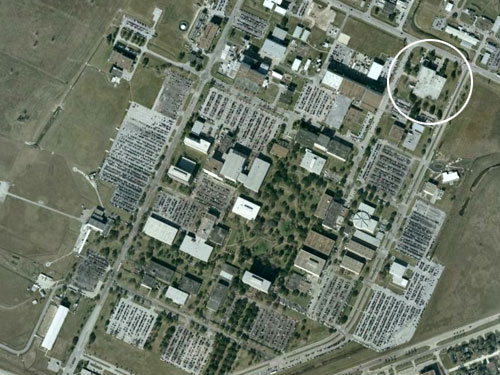 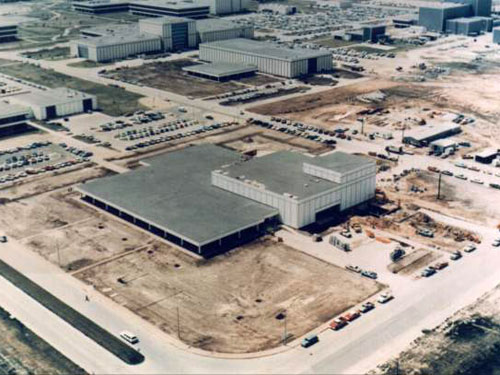
|
Robert Pearlman
Editor Posts: 52878
From: Houston, TX
Registered: Nov 1999
|
 posted 09-08-2007 06:25 PM
posted 09-08-2007 06:25 PM
   
quote:
Originally posted by BMckay:
Can anyone point me in the right direction to find any material in print or online regarding the old LRL and the current one?
Try these links: |
hlbjr
Member Posts: 582
From: Delray Beach Florida USA
Registered: Mar 2006
|
 posted 09-09-2007 07:00 AM
posted 09-09-2007 07:00 AM
   
Thanks Robert. As usual you deliver. Is the building larger than originally constructed or unchanged? |
Robert Pearlman
Editor Posts: 52878
From: Houston, TX
Registered: Nov 1999
|
 posted 09-09-2007 07:34 AM
posted 09-09-2007 07:34 AM
   
The building, to my knowledge, remains unchanged in size but it is no longer where the moon rocks are housed. The original Lunar Receiving Laboratory was in Building 37 (circled above), which is now the Life Sciences Laboratory. The LRL had enough room to process the samples, but not enough space to store them. Building 31N was dedicated as the Lunar Sample Laboratory Facility in 1979, two years after construction began to modify the building for the purpose. The current LSLF houses 80 percent of the moon rocks returned by Apollo, with the remaining samples stored off-site. The original LRL covered 83,000 square feet, including a crew reception area, a vacuum laboratory, sample laboratories and an administrative and support area. The LSLF is a two-story, 14,000 square foot facility. |
compass
Member Posts: 42
From: uk
Registered: May 2007
|
 posted 09-09-2007 09:13 AM
posted 09-09-2007 09:13 AM
  
Do lunar rock samples continue to be studied/examined or are they mostly in long term storage and only brought out once and a while when the need arises? I have also heard that the U.S. over the years has gifted or loaned samples to heads of state, scientific research establishments, etc. and there may be a number of theses samples un- accounted for... does anyone know? |
Robert Pearlman
Editor Posts: 52878
From: Houston, TX
Registered: Nov 1999
|
 posted 09-09-2007 10:22 AM
posted 09-09-2007 10:22 AM
   
According to NASA, nearly 400 lunar samples are loaned each year for research and teaching projects: NASA provides lunar rock, soil, and regolith-core samples for both destructive and non-destructive analysis in pursuit of new scientific knowledge. Requests are considered for both basic studies in planetary science and applied studies in lunar materials beneficiation and resource utilization.NASA [also] provides for a limited number of rock samples to be used for either short-term or long-term displays at museums, planetariums, expositions, or professional events that are open to the public. Requests for such display samples are administratively handled by the JSC Public Affairs Office (PAO). Small samples of representative lunar rocks and soils, embedded in rugged acrylic disks suitable for classroom use, are made available for short-term loan to qualified school teachers. NASA [has also] prepared thin sections of representative lunar rocks on rectangular 1 x 2-inch glass slides, with special safety frames, that are suitable for use in college and university courses in petrology and microscopic petrography for advanced geology students. With the exception of destructive analysis, during which the sample is, as implied, destroyed, the U.S. has only gifted lunar material twice in history. Lunar material returned by Apollo 11 was gifted to 135 nations. Each received a plaque with 0.05 grams of dust encased in acrylic along with a flag of their nation that was carried on-board the mission. Displays were also presented to the United Nations and Vatican City. While on the Moon, Apollo 17 moonwalkers Gene Cernan and Harrison Schmitt dedicated a sample they collected as the Goodwill moon rock and upon their return, 135 1.142-gram pieces were cut from that stone. Like the earlier presentations, they were encased in acrylic and attached to a plaque bearing the flown flag of the country to which it was to be gifted. These 272 samples are, to the best of my knowledge, the only Apollo-returned lunar rocks that are no longer U.S. property. In both the Apollo 11 and Apollo 17 instances, they were presented to the head of state on behalf of the people of his/her country. In most cases, under the laws of those nations, the rock became public property and not the possession of any one individual. With regards to missing samples, of the United States' own holdings, very little (less than a few grams) has gone missing and NASA keeps very detailed regards as to the current location of those rocks they have loaned. There have been confirmed and unconfirmed reports of some of the goodwill A11/A17 rocks having been stolen or officially having gone missing. In at least one case, the plaque was recovered and returned to the nation. Others are "missing" only so much as those who have tried to track the current whereabouts of such presentations have been unsuccessful in finding them. It may be that they are sitting exactly where that country desires them to be, but the researchers (myself included) haven't found it yet. If you visit the link above for the A17 samples, you can see the known locations for those I, or our readers, have discovered. I plan to start a similar guide to the A11 samples as well. (In 2004, NASA began presenting moon rocks in the name of their Ambassadors of Exploration, astronauts and other key figures who made key contributions to the Mercury, Gemini and Apollo programs. These samples remain U.S. property but are on long-term public display at a museum or public facility of the honorees choice.) |
Robert Pearlman
Editor Posts: 52878
From: Houston, TX
Registered: Nov 1999
|
 posted 07-08-2008 12:35 AM
posted 07-08-2008 12:35 AM
   
The New York Times: The Keepers of the Moon In the lab, the Moon rocks look nondescript -- dark gray basalt, a whitish mineral called anorthosite and mixtures of the two with crystals thrown in. Yet nearly 40 years after the Apollo astronauts brought the first rocks back to Earth, these pieces of the Moon are still providing scientists with new secrets from another world."We call this one the 'genesis' rock, because it was formed close to the time the Moon solidified about 4.5 billion years ago," said Carlton C. Allen, pointing to a light-colored stone about the size and shape of a large artist's eraser, resting inside a glove box filled with inert nitrogen gas. "We know the Big Bang happened about 14.5 billion years ago," Mr. Allen said, "and this rock is a third that old. You will never see a solid piece of stuff in our solar system that is any older." Mr. Allen is the astromaterials curator at the Johnson Space Center, home of the Lunar Sample Laboratory Facility, a secure repository opened in 1979 to house 842 pounds of Moon rocks and soil collected by astronauts in six visits. The rocks on the lunar surface, lying virtually unchanged in a weatherless vacuum since their formation, offer opportunities to investigate the origin and evolution of the solar system available nowhere else, and the study deepens with each new generation of scientists and scientific instruments. Each year an independent peer review panel evaluates new research proposals, and curators mail out about 400 lunar samples to 40 to 50 scientists worldwide. Almost all are less than one gram in size. "We don't hand them out, we only loan them," Mr. Allen said. "We're not planning to run out any time soon." |
Robert Pearlman
Editor Posts: 52878
From: Houston, TX
Registered: Nov 1999
|
 posted 09-09-2008 12:33 AM
posted 09-09-2008 12:33 AM
   
On Monday, NASA provided the media a chance to tour the Lunar Receiving Lab at Johnson Space Center.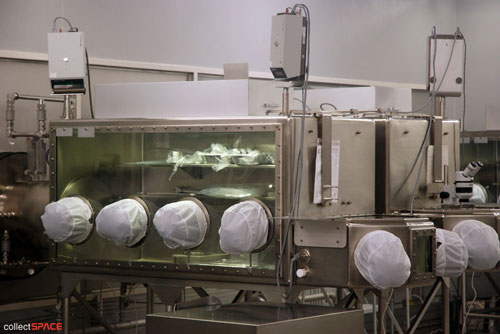 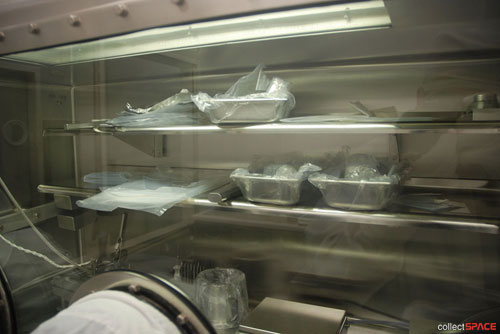
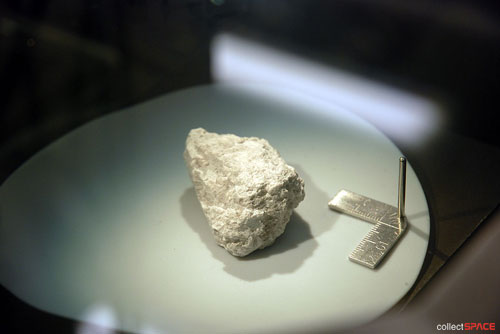
Apollo 15's Genesis Rock 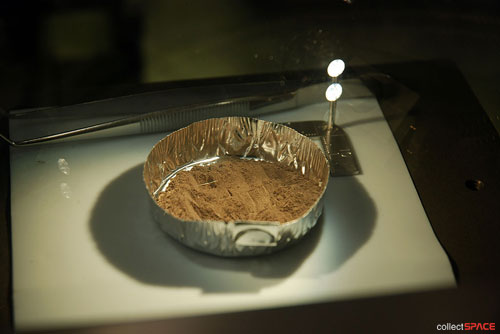
Apollo 17's Orange Soil |
MCroft04
Member Posts: 1856
From: Smithfield, Me, USA
Registered: Mar 2005
|
 posted 09-09-2008 04:52 PM
posted 09-09-2008 04:52 PM
   
Wow! Two of the most famous geological samples brought back from the moon. Like always, I'm jealous. |
Robert Pearlman
Editor Posts: 52878
From: Houston, TX
Registered: Nov 1999
|
 posted 06-25-2009 07:05 PM
posted 06-25-2009 07:05 PM
   
NASA release NASA Gives Public Look Inside Apollo Moon Rock VaultThe public will have an opportunity to take a virtual tour of the Apollo Lunar Sample Processing Lab and Storage Vaults at NASA's Johnson Space Center in Houston and ask scientists Gary Lofgren and Andrea Mosie questions via Ustream and Twitter from 12 p.m. to 1 p.m. EDT on July 2. The public can submit questions to Johnson's Twitter account, @NASA_Johnson, beginning today and via Ustream live during the event. The tour and the question-and-answer session also will be broadcast live on NASA TV. |
Robert Pearlman
Editor Posts: 52878
From: Houston, TX
Registered: Nov 1999
|
 posted 11-29-2010 12:59 PM
posted 11-29-2010 12:59 PM
   
Johnson Space Center is hiring a new Lunar Sample Curator (talk about a dream job for a professional geologist and space history enthusiast...) This is a heads-up that a civil servant position will be opening at the NASA Johnson Space Center for the position of Lunar Sample Curator. The successful candidate will oversee the Apollo lunar sample collection and the lunar sample laboratory suite, and will be encouraged to perform independent research. If you have any questions about the position feel free to contact Carlton Allen, Astromaterials Curator, by email or by phone at 281-483-5126.
JSC Human Resources will post the vacancy announcement on USAJOBS in early January, if all goes as planned. The announcement will contain details on the position. In the meantime, anyone interested may want to get familiar with USAJOBS, specifically with the resume builder feature. For questions on the USAJOBS application process, contact Candy Hunt, HR representative. |
MCroft04
Member Posts: 1856
From: Smithfield, Me, USA
Registered: Mar 2005
|
 posted 11-29-2010 08:59 PM
posted 11-29-2010 08:59 PM
   
quote:
Originally posted by Robert Pearlman:
...talk about a dream job for a professional geologist and space history enthusiast
I agree. Too bad no oil was discovered in the lunar rocks or I might consider moving back to Houston. But I can dream about how fun that job would be. |
Philip
Member Posts: 6266
From: Brussels, Belgium
Registered: Jan 2001
|
 posted 03-12-2012 10:05 AM
posted 03-12-2012 10:05 AM
   
Everybody is familiar with the photos of NASA managers carrying the first containers with Apollo lunar samples to the Lunar Receiving Lab (LRL) where the moon rocks were scientifically processed.However I'm curious to see photos of the samples being moved from the LRL (building 37) to their current storage, the Lunar Sample Laboratory Facility (LSLF) in building 31N at Johnson Space Center, where the Apollo lunar sample reside since 1979. Ref: Lunar Receiving Laboratory Project History (PDF) |
Robert Pearlman
Editor Posts: 52878
From: Houston, TX
Registered: Nov 1999
|
 posted 01-13-2016 09:37 AM
posted 01-13-2016 09:37 AM
   
Ars Technica's Eric Berger recently toured the Astromaterials and Lunar Sample Laboratory Facility (Building 31) at the Johnson Space Center for his article, Inside the vault: A rare glimpse of NASA's otherworldly treasures. Building 31 on the campus of Johnson Space Center lacks the Tower of London's majesty and history. No Queen's Guard stand outside. But this drab, 1960s-era building is nonetheless where NASA keeps the crown jewels of its exploration program. Inside various clean rooms, curators watch over meteorites from Mars and the asteroid belt, cosmic dust, samples of the solar wind, comet particles, and, of course, hundreds of kilograms of Moon rocks.In late December, Ars spent a day visiting these collections, including the rarely accessed Genesis Lab. While our request for a Moon rock keepsake was sadly rebuffed, we nonetheless got a VIP tour of every astromaterial NASA has collected from other bodies in the Solar System and beyond. With Senior Space Editor Eric Berger providing the words and Senior Technology Editor Lee Hutchinson capturing the photos, we can now offer an unprecedented look at how NASA protects its rarest and most valuable off-world samples. |
Headshot
Member Posts: 1326
From: Vancouver, WA, USA
Registered: Feb 2012
|
 posted 01-18-2016 04:55 PM
posted 01-18-2016 04:55 PM
   
Have any of the Apollo astronaut moonwalkers visited the LSLF recently? Would they be allowed access to examine a sample or two if they so asked? |
Robert Pearlman
Editor Posts: 52878
From: Houston, TX
Registered: Nov 1999
|
 posted 09-23-2019 04:18 PM
posted 09-23-2019 04:18 PM
   
Building 37, the former Lunar Receiving Laboratory and temporary crew quarters where the Apollo 11, Apollo 12 and Apollo 14 crews lived during their post-mission quarantine periods, is slated for destruction, reports the Houston Chronicle. Everett Gibson, an emeritus senior scientist, at Johnson, worked in the lab during Apollo 12 through 17 missions. It's hard to see the building go, he said, but saving it for historical purposes would be cost prohibitive. He's also not sure the public interest is there."Sometimes in life we have to make hard decisions, and I don't know what you could do with it," he said. "It's sitting out there rotting and the cost to keep is going is just horrendous. I don't think it's that exciting to a man and a woman on the street." So [Sandra Tetley, Johnson’s historic preservation officer] is moving forward with the interpretative park, which she hopes will be accessible to visitors of Space Center Houston via tram tours. She plans to save the original stairs, pillars and walkways, as well as many pieces of equipment inside the building as she can. |
SpaceAholic
Member Posts: 5382
From: Sierra Vista, Arizona
Registered: Nov 1999
|
 posted 09-23-2019 05:10 PM
posted 09-23-2019 05:10 PM
   
The inventory of tangible artifacts continues its slow and steady march towards eradication, ultimately transforming Project Apollo into little more then mythology. |
Robert Pearlman
Editor Posts: 52878
From: Houston, TX
Registered: Nov 1999
|
 posted 09-23-2019 06:24 PM
posted 09-23-2019 06:24 PM
   
That is a tad dramatic, given the sheer number of Apollo artifact exhibitions at museums and the various preserved facilities, such as the recently-restored Apollo Mission Operations Control Room. In fact, an argument could be made that more artifact-based monuments exist as a testament to Apollo today than any time in its 50 year history.As for Building 37, it ceased being the Lunar Receiving Laboratory in 1970. The majority of its history was in service to NASA's Life Sciences division, an aspect to its legacy that no one is seeking to preserve, even the historians involved. I would love to have seen the building retained and converted to a museum, but to do so would require more than a restoration, but a complete recreation of its LRL condition, which was long lost to renovations in support of the building's ongoing use for the past 30 years. |
thisismills
Member Posts: 562
From: Michigan
Registered: Mar 2012
|
 posted 09-26-2019 07:34 AM
posted 09-26-2019 07:34 AM
   
Understand the decision but still disappointing to see this space go by the wayside. This article does show that time has taken its toll on the interior. Hoping that some artifacts are saved for display at a later date. Is there a plan to document the building in photos before destruction?If the "37" on the outside of the building is destined for a scrap heap, I'd give it a good home, just sayin'. |
Gordon Eliot Reade
Member Posts: 261
From: California
Registered: Jun 2015
|
 posted 05-01-2022 01:42 PM
posted 05-01-2022 01:42 PM
   
On a recent tour of Johnson Space Center, one thing that made me unhappy was seeing the chain link fence around the Lunar Receiving Lab and being told that it was scheduled for demolition.Editor's note: Threads merged. |
SkyMan1958
Member Posts: 1386
From: CA.
Registered: Jan 2011
|
 posted 05-01-2022 03:45 PM
posted 05-01-2022 03:45 PM
   
While I assume there are no current plans about where future Lunar/Martian samples would be studied, if Mars sample return works as planned, and more or less to schedule, it would not surprise me in the least that they are demolishing LRL now to at least lobby to build a new generation sample receiving facility... nor, given the political budget cycles, that they are doing this many years in advance. Let's face it, many NASA building projects take far longer to build (and at far higher prices) than originally thought. |
Robert Pearlman
Editor Posts: 52878
From: Houston, TX
Registered: Nov 1999
|
 posted 08-09-2024 05:41 PM
posted 08-09-2024 05:41 PM
   
I meant to check in on this earlier, but between late-February and April of this year, Building 37, the former home of the Apollo-era Lunar Receiving Laboratory, was tore down. As of four months ago, all that remained to be removed was the building's foundation.Google Maps/Earth have yet to update their imagery, but these photos (via Q Recycling & Construction Services) show the building bringing brought down. An interpretative park was planned to take the building's place, but at last word (April 2024), there may not be the funding to make that a reality. 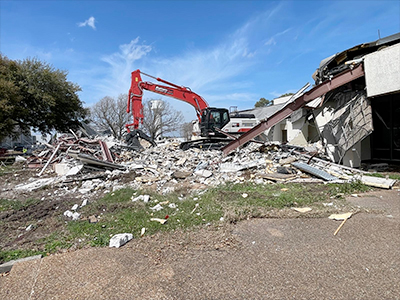 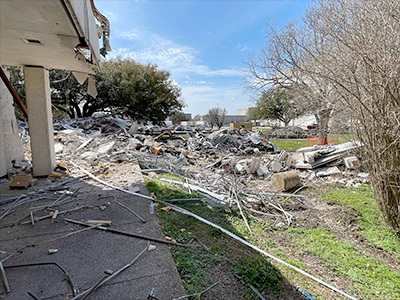
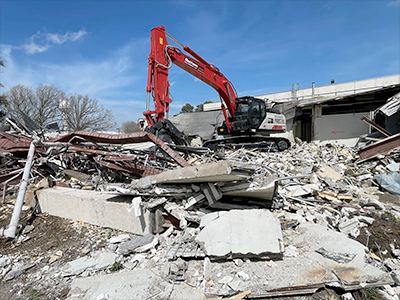
|























